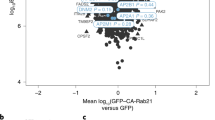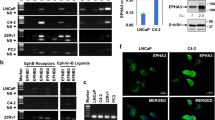Abstract
In epithelial cells, tyrosine kinases induce the tyrosine phosphorylation and ubiquitination of the E-cadherin complex, which induces endocytosis of E-cadherin. With a modified yeast 2-hybrid system, we isolated Hakai, an E-cadherin binding protein, which we have identified as an E3 ubiquitin-ligase. Hakai contains SH2, RING, zinc-finger and proline-rich domains, and interacts with E-cadherin in a tyrosine phosphorylation-dependent manner, inducing ubiquitination of the E-cadherin complex. Expression of Hakai in epithelial cells disrupts cell–cell contacts and enhances endocytosis of E-cadherin and cell motility. Through dynamic recycling of E-cadherin, Hakai can thus modulate cell adhesion, and could participate in the regulation of epithelial–mesenchymal transitions in development or metastasis.
This is a preview of subscription content, access via your institution
Access options
Subscribe to this journal
Receive 12 print issues and online access
$209.00 per year
only $17.42 per issue
Buy this article
- Purchase on Springer Link
- Instant access to full article PDF
Prices may be subject to local taxes which are calculated during checkout








Similar content being viewed by others
Accession codes
References
Takeichi, M. Morphogenetic roles of classic cadherins. Curr. Opin. Cell Biol. 7, 619–627 (1995).
Kemler, R. Classical cadherins. Semin. Cell Biol. 3, 149–155 (1992).
Behrens, J., Mareel, M. M., Van Roy, F. M. & Birchmeier, W. Dissecting tumour cell invasion: epithelial cells acquire invasive properties after the loss of uvomorulin-mediated cell–cell adhesion. J. Cell Biol. 108, 2435–2447 (1989).
Larue, L., Ohsugi, M., Hirchenhain, J. & Kemler, R. E-cadherin null mutant embryos fail to form a trophectoderm epithelium. Proc. Natl Acad. Sci. USA 91, 8263–8267 (1994).
Riethmacher, D., Brinkmann, V. & Birchmeier, C. A targeted mutation in the mouse E-cadherin gene results in defective preimplantation development. Proc. Natl Acad. Sci. USA 92, 855–859 (1995).
Perl, A. K., Wilgenbus, P., Dahl, U., Semb, H. & Christofori, G. A causal role for E-cadherin in the transition from adenoma to carcinoma. Nature 392, 190–193 (1998).
Weidner, K. M., Behrens, J., Vandekerckhove, J. & Birchmeier, W. Scatter factor: molecular characteristics and effect on the invasiveness of epithelial cells. J. Cell Biol. 111, 2097–2108 (1990).
Stoker, M. & Gherardi, E. Regulation of cell movement: the motogenic cytokines. Biochim. Biophys. Acta 1072, 81–102 (1991).
Behrens, J. et al. Loss of epithelial differentiation and gain of invasiveness correlates with tyrosine phosphorylation of the E-cadherin/β-catenin complex in cells transformed with a temperature-sensitive v-SRC gene. J. Cell Biol. 120, 757–766 (1993).
Hamaguchi, M. et al. p60v-src causes tyrosine phosphorylation and inactivation of the N-cadherin-catenin cell adhesion system. EMBO J. 12, 307–314 (1993).
Bauer, A., Lickert, H., Kemler, R. & Stappert, J. Modification of the E-cadherin-catenin complex in mitotic Madin-Darby canine kidney epithelial cells. J. Biol. Chem. 273, 28314–28321 (1998).
Kamei, T. et al. Coendocytosis of cadherin and c-Met coupled to disruption of cell–cell adhesion in MDCK cells — regulation by Rho, Rac and Rab small G proteins. Oncogene 18, 6776–6784 (1999).
Le, T. L., Yap, A. S. & Stow, J. L. Recycling of E-cadherin: a potential mechanism for regulating cadherin dynamics. J. Cell Biol. 146, 219–232 (1999).
Hershko, A. & Ciechanover, A. The ubiquitin system. Annu. Rev. Biochem. 67, 425–479 (1998).
Hicke, L. Gettin' down with ubiquitin: turning off cell-surface receptors, transporters and channels. Trends Cell Biol. 9, 107–112 (1999).
Strous, G. J. & Govers, R. The ubiquitin-proteasome system and endocytosis. J. Cell Sci. 112, 1417–1423 (1999).
Hicke, L., Zanolari, B. & Riezman, H. Cytoplasmic tail phosphorylation of the α-factor receptor is required for its ubiquitination and internalization. J. Cell Biol. 141, 349–358 (1998).
Joazeiro, C. A. et al. The tyrosine kinase negative regulator c-Cbl as a RING-type, E2-dependent ubiquitin-protein ligase. Science 286, 309–312 (1999).
Levkowitz, G. et al. Ubiquitin ligase activity and tyrosine phosphorylation underlie suppression of growth factor signaling by c-Cbl/Sli-1. Mol. Cell 4, 1029–1040 (1999).
Deveraux, Q., Ustrell, V., Pickart, C. & Rechsteiner, M. A 26 S protease subunit that binds ubiquitin conjugates. J. Biol. Chem. 269, 7059–7061 (1994).
Roth, A. F. & Davis, N. G. Ubiquitination of the yeast α-factor receptor. J. Cell Biol. 134, 661–674 (1996).
Terrell, J., Shih, S., Dunn, R. & Hicke, L. A function for monoubiquitination in the internalization of a G protein-coupled receptor. Mol. Cell 1, 193–202 (1998).
Chau, V. et al. A multiubiquitin chain is confined to specific lysine in a targeted short-lived protein. Science 243, 1576–1583 (1989).
Galan, J. & Haguenauer, T. R. Ubiquitin lys63 is involved in ubiquitination of a yeast plasma membrane protein. EMBO J. 16, 5847–5854 (1997).
Horak, J. & Wolf, D. H. Catabolite inactivation of the galactose transporter in the yeast Saccharomyces cerevisiae: ubiquitination, endocytosis, and degradation in the vacuole. J. Bacteriol. 179, 1541–1549 (1997).
Schaeper, U. et al. Coupling of Gab1 to c-Met, Grb2, and Shp2 mediates biological responses. J. Cell Biol. 149, 1419–1432 (2000).
Gumbiner, B. M. Regulation of cadherin adhesive activity. J. Cell Biol. 148, 399–404 (2000).
Xu, Y., Guo, D. F., Davidson, M., Inagami, T. & Carpenter, G. Interaction of the adaptor protein Shc and the adhesion molecule cadherin. J. Biol. Chem. 272, 13463–13466 (1997).
Kozak, M. An analysis of 5′-noncoding sequences from 699 vertebrate messenger RNAs. Nucleic Acids Res. 15, 8125–8148 (1987).
Lorick, K. L. et al. RING fingers mediate ubiquitin-conjugating enzyme (E2)-dependent ubiquitination. Proc. Natl Acad. Sci. USA 96, 11364–11369 (1999).
Thoreson, M. A. et al. Selective uncoupling of p120(ctn) from E-cadherin disrupts strong adhesion. J. Cell Biol. 148, 189–202 (2000).
Wang, Y., Yeung, Y. G., Langdon, W. Y. & Stanley, E. R. c-Cbl Is Transiently Tyrosine-phosphorylated, Ubiquitinated, and Membrane-targeted following CSF-1 Stimulation of Macrophages. J. Biol. Chem. 271, 17–20 (1996).
Tagawa, M. et al. Expression of novel DNA-binding protein with zinc finger structure in various tumour cells. J. Biol. Chem. 265, 20021–20026 (1990).
Weidner, K. M. et al. Interaction between Gab1 and the c-Met receptor tyrosine kinase is responsible for epithelial morphogenesis. Nature 384, 173–176 (1996).
Nagafuchi, A., Ishihara, S. & Tsukita, S. The roles of catenins in the cadherin-mediated cell adhesion: functional analysis of E-cadherin-α-catenin fusion molecules. J. Cell Biol. 127, 235–245 (1994).
Meng, W., Sawasdikosol, S., Burakoff, S. J. & Eck, M. J. Structure of the amino-terminal domain of Cbl complexed to its binding site on ZAP-70 kinase. Nature 398, 84–90 (1999).
Takata, K. & Singer, S. J. Phosphotyrosine-modified proteins are concentrated at the membranes of epithelial and endothelial cells during tissue development in chick embryos. J. Cell Biol. 106, 1757–1764 (1988).
Maher, P. A. & Pasquale, E. B. Heat shock induces protein tyrosine phosphorylation in cultured cells. J. Cell Biol. 108, 2029–2035 (1989).
Tsukita, S. et al. Specific proto-oncogenic tyrosine kinases of src family are enriched in cell-to-cell adherens junctions where the level of tyrosine phosphorylation is elevated. J. Cell Biol. 113, 867–879 (1991).
Ukropec, J. A., Hollinger, M. K., Salva, S. M. & Woolkalis, M. J. SHP2 association with VE-cadherin complexes in human endothelial cells is regulated by thrombin. J. Biol. Chem. 275, 5983–5986 (2000).
Tsukamoto, T. & Nigam, S. K. Cell–cell dissociation upon epithelial cell scattering requires a step mediated by the proteasome. J. Biol. Chem. 274, 24579–24584 (1999).
Taya, S., Yamamoto, T., Kanai-Azuma, M., Wood, S. A. & Kaibuchi, K. The deubiquitinating enzyme Fam interacts with and stabilizes β-catenin. Genes Cells 4, 757–767 (1999).
Pece, S., Chiariello, M., Murga, C. & Gutkind, J. S. Activation of the protein kinase Akt/PKB by the formation of E-cadherin-mediated cell–cell junctions. Evidence for the association of phosphatidylinositol 3-kinase with the E-cadherin adhesion complex. J. Biol. Chem. 274, 19347–19351 (1999).
Birchmeier, W. & Behrens, J. Cadherin expression in carcinomas: role in the formation of cell junctions and the prevention of invasiveness. Biochim. Biophys. Acta 1198, 11–26 (1994).
Behrens, J. et al. Functional interaction of β-catenin with the transcription factor LEF-1. Nature 382, 638–642 (1996).
Nuber, U., Schwarz, S., Kaiser, P., Schneider, R. & Scheffner, M. Cloning of human ubiquitin-conjugating enzymes UbcH6 and UbcH7(E2-F1) and characterization of their interaction with E6-AP and RSP5. J. Biol. Chem. 271, 2795–2800 (1996).
Acknowledgements
We thank C. Birchmeier and U. Schaeper for critical reading of the manuscript. A. Dell'Oro is acknowledged for technical help. We also thank U. Lenk for help with the in vitro ubiquitination assays, A. Ciechanover for technical advice on pulse–chase assays, and D. Bohmann for providing the pBSSR-HA–ubiquitin construct. This work was supported by a grant from the Deutsche Forschungsgemeinshaft (DFG). Y.F. received support from the Japan-Europe Scientists Exchange Program from the Ciba-Geigy Foundation of Japan and a Postdoctoral Fellowship for Research Abroad from the Japan Society for the Promotion of Science.
Author information
Authors and Affiliations
Corresponding authors
Supplementary information
Supplementary figures
Figure S1 Northern blotting of Hakai using RNAs from adult mouse tissues and from mouse embryos. (PDF 271 kb)
Figure S2 Effect of Hakai on the MAPK pathway.
Figure S3 A suggested molecular structure of Hakai.
Rights and permissions
About this article
Cite this article
Fujita, Y., Krause, G., Scheffner, M. et al. Hakai, a c-Cbl-like protein, ubiquitinates and induces endocytosis of the E-cadherin complex. Nat Cell Biol 4, 222–231 (2002). https://doi.org/10.1038/ncb758
Received:
Revised:
Accepted:
Published:
Issue Date:
DOI: https://doi.org/10.1038/ncb758
This article is cited by
-
Exploiting E3 ubiquitin ligases to reeducate the tumor microenvironment for cancer therapy
Experimental Hematology & Oncology (2023)
-
Endocytosis in cancer and cancer therapy
Nature Reviews Cancer (2023)
-
Dynamics and functions of E-cadherin complexes in epithelial cell and tissue morphogenesis
Marine Life Science & Technology (2023)
-
Pepino mosaic virus antagonizes plant m6A modification by promoting the autophagic degradation of the m6A writer HAKAI
aBIOTECH (2023)
-
Two zinc finger proteins with functions in m6A writing interact with HAKAI
Nature Communications (2022)



